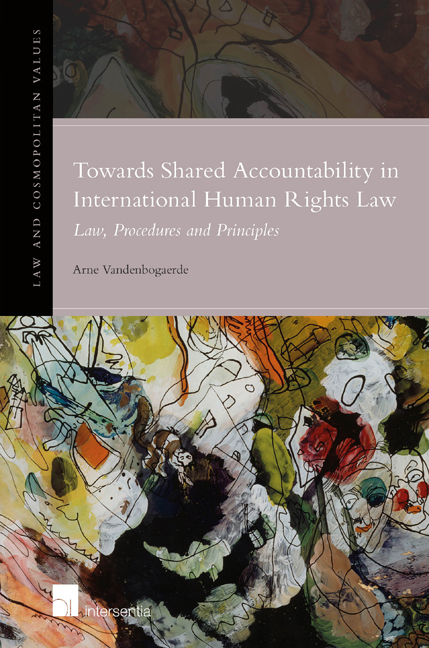Book contents
- Frontmatter
- Preface
- Acknowledgment
- Contents
- List of Abbreviations
- Chapter 1 Introduction
- PART I UNDERSTANDING ACCOUNTABILITY
- PART II ACCOUNTABILITY IN INTERNATIONAL AND REGIONAL HUMAN RIGHTS LAW: PROCESSES, PRACTICE AND LIMITS
- Chapter 3 State Reporting Procedures at the International and Regional Level
- Chapter 4 Individual, Collective and Inter-State Complaint Procedures in the International and Regional Accountability Framework
- Chapter 5 Inquiry Procedures in the International and Regional Accountability Framework
- Chapter 6 International Peer-Review Accountability Mechanisms
- Chapter 7 Special Procedures in the International and Regional Systems
- Conclusions Part II
- PART III CONTOURS OF A MULTI-DUTY BEARER FRAMEWORK
- Conclusion: Contours and Viability of A Multi-Duty-Bearer Framework
- Bibliography
- Law and Cosmopolitan Values
- Instructions to authors
Conclusions Part II
from PART II - ACCOUNTABILITY IN INTERNATIONAL AND REGIONAL HUMAN RIGHTS LAW: PROCESSES, PRACTICE AND LIMITS
Published online by Cambridge University Press: 13 December 2017
- Frontmatter
- Preface
- Acknowledgment
- Contents
- List of Abbreviations
- Chapter 1 Introduction
- PART I UNDERSTANDING ACCOUNTABILITY
- PART II ACCOUNTABILITY IN INTERNATIONAL AND REGIONAL HUMAN RIGHTS LAW: PROCESSES, PRACTICE AND LIMITS
- Chapter 3 State Reporting Procedures at the International and Regional Level
- Chapter 4 Individual, Collective and Inter-State Complaint Procedures in the International and Regional Accountability Framework
- Chapter 5 Inquiry Procedures in the International and Regional Accountability Framework
- Chapter 6 International Peer-Review Accountability Mechanisms
- Chapter 7 Special Procedures in the International and Regional Systems
- Conclusions Part II
- PART III CONTOURS OF A MULTI-DUTY BEARER FRAMEWORK
- Conclusion: Contours and Viability of A Multi-Duty-Bearer Framework
- Bibliography
- Law and Cosmopolitan Values
- Instructions to authors
Summary
The aim of Part II was to identify clearly the accountability gaps that exist in the international and regional systems of ESC rights protection. The objective of the above review of the international and regional accountability mechanisms designed to deal with ESC rights was to analyse their scope, procedure and practice. We can make a number of overarching conclusions in this regard.
A first conclusion is that the accountability mechanisms in international and regional human rights law are not territorially restricted. There are no inherent restrictions of a procedural or substantive nature that limit a priori the accountability of States to what happens within their borders. Most of the accountability mechanisms have a broad mandate to accommodate extraterritorial issues. The communications procedures have the most detailed set of rules or ‘roadmaps’ of accountability. This is because they can determine the responsibility of the State for a violation. There is less need for procedural and substantive rules and regulations in accountability procedures that do not result in a finding of responsibility. The communications procedures, despite having detailed rules, do not reveal any formal hurdles against the extraterritorial application of a treaty. What about the practice?
A second consequent observation is that the international and in particular the regional mechanisms have not produced much relevant practice for this research. The communications procedures of the CRC and CESCR have only recently entered into force and therefore have not yet produced any relevant practice. The case law in relation to extraterritorial obligations is found at the regional level and in the field of civil and political rights. We have indicated that the ECtHR, the IACHR and the ACHR have recognized the extraterritorial application of human rights treaties but so far only in limited instances. As a consequence, the case law does not enhance our understanding of the attribution of extraterritorial obligations in the field of ESC rights, in particular in relation to positive obligations such as the duties to fulfil and protect.
Most practice at the international level is found in the State reporting procedure, to a certain extent the UPR, and the special procedures. The treaty bodies are supposed to be the most authoritative bodies, yet the vagueness of the CESCR in dealing with States’ extraterritorial obligations only exacerbates the indeterminacy surrounding extraterritorial violations.
- Type
- Chapter
- Information
- Towards Shared Accountability in International Human Rights LawLaw, Procedures and Principles, pp. 171 - 174Publisher: IntersentiaPrint publication year: 2016

